An Interview with Mike Todd, Jr., 1995 |
Read more
at in70mm.com The 70mm Newsletter |
| Written and posted by permission from: Roy Frumkes, Editor, Films In Review. It was meant for the Mar/April 1997 issue of "Films in Review" but the magazine stopped printing with the issue. The interview was partially published in the Classic Images Newspaper. |
Date: 09.01.2004 Updated: 06.05.2023 |
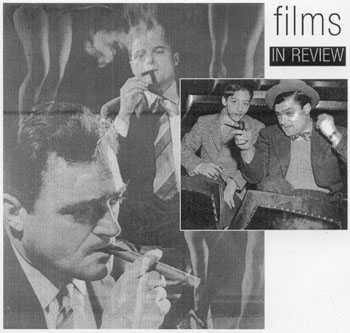 Season's Greetings from Films In Review Magazine Season's Greetings from Films In Review MagazineWOW, here I am looking out at you, but the pages I'm looking out from aren't familiar...this isn't the size and print of my beloved Films In Review...? Oh, yes...now l remember. There was that generous invitation from editor Bob King to contribute to Classic Images' special holiday issue featuring both FIR and CI articles. l thought it was a wonderful idea. Even though FIR is now on the world wide web, I'm sure many of you would enjoy the printed version, and it's a nice way to stay in touch with our readers while we continue to pull the publication out of dormancy. Plus, this is a good way to introduce many of our readers to another worthy, similar-minded publication. It’s a pleasure to be a part of CI for this moment in history - and it’s going to become a real collectible! I've chosen an FIR article that l think will appeal to readers of both magazines. Let me preface by saying that I grew up in the 50's, and films such as “The Ten Commandments” and "Around the World in 80 Days" were among my introductions to the film going experience. My grandfather had been Houdini's agent, and my mother had done some film acting, so there was a respect for cinema when my folks took me to these movies. The souvenir books were like Holy Grails to me. And the large reserved seat tickets ended up neatly filed away in my top desk drawer. TV wasn't in color yet. There were no videotapes, no LaserDiscs, no hundred-cable stations, no multiplexes. Dannon was still selling prune yogurt. It was a different world. And while I'm in love with the films of today, I'm always anxious to revisit that earlier, magical world, and share it with FIR readers who were growing up then, like I was, or with the more recent audiences who've only HEARD of those glory days. Unbeknownst to me at the time, Mike Todd, who gave movie-goers two of the most impressive film format experiences - Cinerama and Todd-AO - was not even a Hollywood producer. FIR was fortunate in tracking down Mike Todd, Jr. Through an interview over the phone, he gave us permission to open his father's file cabinets, located in a dark basement in White Plains, New York, which had been unopened for decades. lt had the aura of an archaeological dig. Among the findings were the original color acetate cels from the "Around the World in 80 Days" title sequence, all the contracts for the film, Todd, Sr.'s own souvenir books, and endless envelopes upon envelopes of 35mm still camera color prints of the “80 Days” shoot - all of them faded to pink. We sifted through thousands of stills and documents that day, and borrowed what you'll be seeing below. Roy Frumkes Editor, Films In Review |
Further
in 70mm reading: Mike Todd Jr.'s "Scent of Mystery" in Smell-O-Vision Mike Todd's "Around the World in 80 Days" in Todd-AO Oliver Michael Todd in Conversation Susan Jane Todd in Conversation Cyrus Todd in Conversation Todd-AO Premiere List Mike Todd, Jr. Obituary Todd-AO The Early Days of Todd-AO |
Exclusive interview; conducted from Todd, Jr.'s home in Borris, Ireland |
|
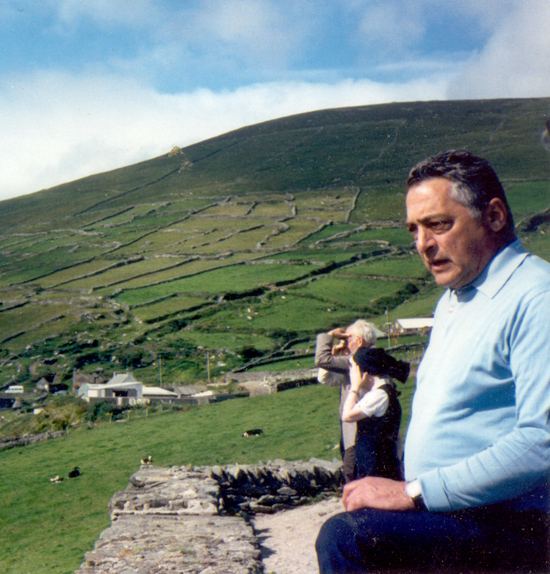 Film producer and 70mm Newsletter subscriber Mike Todd, Jr. in his beloved Ireland. Private image courtesy Susan M. Todd Film producer and 70mm Newsletter subscriber Mike Todd, Jr. in his beloved Ireland. Private image courtesy Susan M. ToddAbe Goldbogen was born on or about June 22, 1907, in Minneapolis, the seventh of eight children of Polish immigrants Chaim and Sophia Kellerman Goldbogen. His formal education came to a halt in the sixth grade when he was kicked out of school after being caught running a crap game in the school yard. Undaunted, by age 19 he had made and lost a million dollars in the construction business in Chicago. • Go to Oliver Michael Todd in Conversation • Go to Susan Jane Todd in Conversation • Go to Cyrus Todd in Conversation He changed his name to Mike Todd when he got into show business. There are differing stories about the origin of “Todd", but he adopted the name Michael from his son. Michael, Jr., actually predated Michael, Sr! Todd, Jr., was involved in much of his fathers film work, including Cinerama, the creation of Todd-AO, and “Around the World in 80 Days” – all outside the auspices of Hollywood. He also saw his father marry and divorce Joan Blondell, and, later, marry Elizabeth Taylor. About Taylor; Todd, Sr., quipped,
After his father's accidental death (on March 23, 1957, when his Lockheed Lodestar went down in a storm over New
Mexico), Todd, Jr., continued in show business, producing a TV special about his
father, as well as the film version of Sylvia Plath's
"The Bell Jar", and the cinematic oddity,
"Scent of Mystery", the only film produced in the olfactory process known as
Smell-O-Vision. ln 1984, he co-authored, with his wife, a book about his father's life entitled
"A Valuable Property". Aside from being
highly entertaining, the biography clearly demonstrates why his father's reputation was that of the greatest theatrical entrepreneur in the
country - if not the world. |
|
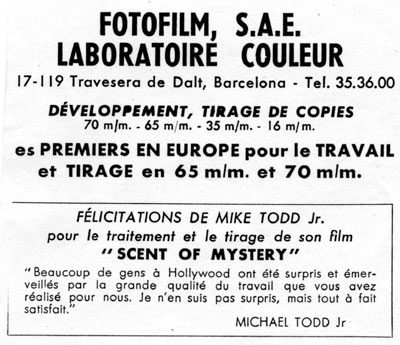 French
advert for Spanish large format laboratory Fotofilm French
advert for Spanish large format laboratory FotofilmFIR: The Venice scene came out great, but you shot it against your father’s orders. Todd: As I said, we had nothing to do, and it was so scenic and appropriate to Cinerama - peripheral vision with the tight canals, like a slow-motion roller coaster ride. Seven minutes of it were used in the final film. After the shooting in Europe, my father became aware that there were alignment and lens problems that Fred Waller, the creator of Cinerama, hadn’t adequately warned him about. The thing that dramatized this most vividly was shooting the Vienna Philharmonic on a huge edifice called the Schonbrunn Monument. The image of the monument went up 15° or 20° at the wings [the left and right panels] and was unusable. Also, a huge amount of light was needed to light La Scala. The story is they had to use every light in Europe and three blocks of generator trucks. So he began thinking about another way to achieve the same experience… FlR: The footage you came back with - which comprised the whole first half of the finished film - was enthusiastically received. Yet the Board of Directors of Cinerama were reluctant to let him finish it. Todd: It was a whole legal thing. Dad was in bankruptcy for losing a lot of money gambling. And then the thing that really killed him was the financial problems putting his play, “Up In Central Park”, into the Hollywood Bowl, and so he was in a perfect position to be screwed. Dad had as much stock in Cinerama as Lowell Thomas, but it had to be sort of held off in the corner so it couldn't be attached in the bankruptcy. Thomas remained aloof from it, but his business guy, Frank Smith, said,
Instead of crying or moaning about it, or starting a lawsuit, Dad figured well, all right, I'm getting screwed, but I’ll show them. There's a better way to do this.
“This Is Cinerama” opened to rave reviews. It was the first film in history to make the frontpage of The New York Times. It only
played 17
theaters worldwide, and still became the third largest grossing film in history up till then. |
|
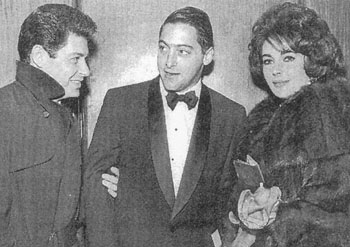 Left
to right: Eddie Fisher, Michael Todd, Jr. and Elizabeth Taylor at the
premiere of "Scent of Mystery" Left
to right: Eddie Fisher, Michael Todd, Jr. and Elizabeth Taylor at the
premiere of "Scent of Mystery"FlR: Feel free Todd: O'Brien was a brilliant optical scientist, but while they spent millions on lenses and the optical printer and all that crap, a guy by the name of Ned Mann went out and bought Leica still camera lenses for about $800, adapted them to the camera, and that's what we ended up using for all the Todd-AO demonstration footage. And it cost nothing. Even the original cameras weren’t created by O'Brien; they were the modified Fearless Superfilm cameras. Joe Schenck told us about them, and we found them out in an army studio on Long Island. So it was all bullshit. Some of "Oklahoma!" was shot with Leica lenses, some with Todd-AO lenses, and they had to discard most of the l28mm bug-eye lens footage because O'Brien's optical printer never worked. But almost all of “Around the World in 80 Days” was shot with cheap lenses, and the results were great because of the 70mm film. FIR: Did you feel with these films that you were on the verge of a new era? Would you get caught up in your father's enthusiasm? Todd: Oh, definitely. He could have sold anybody anything, and he did. He had good ideas. He did eight or nine musicals, and every one of them was a hit. He wasn't so successful with the straight plays, though by and large he made money on the straight plays too, but they weren't hits. But yes, that was the whole thrill of Cinerama, and then Todd-AO. Dad's whole idea goes back to a guy by the name of Gradwell Sears, who was general sales manager of United Artists. He was a sporty but also classy guy who dad hung around with a bit. Grad Sears came to Dad on one occasion, saying,
And my father said,
Sears said,
And so the picture was road-shown and made a comparative fortune for them.
So Dad always had the idea of doing big attractions and road-showing them. Road show was his conception. And the idea of the "big screen" was the way to properly road-show big attractions. What eventually killed "big-screen" was using them to show run-of-the-mill films. That, and the fact that the whole nature of the business changed. |
|
 John
Huston and Michael Todd (right) John
Huston and Michael Todd (right)FIR: What else did your father do to elevate films to roadshow status? Todd: Dad felt that the films he was making were SHOWS rather than movies, and it was literally written in the contract that when a theater played a Todd-AO film there could be no popcorn sold in the theater. That wasn't a joke. It was for real. I doubt if it would fly today. Even then, the concession stand in the drive-ins brought in more than the box office. But he wanted the exhibitors, as well as the public, to realize that they were doing something special when they installed Todd-AO in their theaters. Dad shot the demo reel to convince Rodgers and Hammerstein to do “Oklahoma!” in Todd-AO. The demonstration was in mid-August of 1953, and they loved the process, but they weren't going to relinquish artistic control of the movie to him. Although he was the father of the process, and had a huge slice of the stock, he didn't have the controlling interest, and the board voted with Rodgers and Hammerstein. Nonetheless, their involvement meant that Dad's credibility in the industry was totally restored, and he went out to find a Todd-AO project of his own. He went through a whole bunch of things. He flew to Wales with a couple of cases of champagne and caviar to convince John Huston to stop production on “Moby Dick” and have it re-shot in Todd-AO. Huston actually went for the idea, but the producers didn't. He later spoke with Huston about doing “The Man Who Would Be King” with Humphrey Bogart and Gary Cooper. [Huston wound up making a very good film out of it 15 years later with Sean Connery and Michael Caine] He considered “Richard III” with Laurence Olivier, to be co-produced with Sir Alexander Korda - though Shakespeare wasn't really an ideal vehicle for roller coasters - which was the kind of use Dad wanted to make of the process, and he also felt a conflict of control might arise between him and Olivier similar to the one he had with Rodgers and Hammerstein. Then he went to Moscow to convince the Russians to co-produce “War and Peace” with him. He was told that they had already invented Cinerama, 3-D, Todd-AO, and were planning their own version of the film. He ended up back in Hollywood for the beginning of filming on “Oklahoma!”, made sure the cornfield scene was in accordance with his roller coaster standards, and was also responsible for Shirley Jones getting the lead. |
|
 Fisher,
Todd, Jr. and unknown and Milton Berle (standing) Fisher,
Todd, Jr. and unknown and Milton Berle (standing)FIR: Finally, he settled on “Around the World in 80 Days”. Todd: He had put $40,000 into developing a musical of “80 Days” with Orson Welles, which never got off the ground. Korda had bought the rights to the musical, and eventually got Dad re-interested in it. The film was adapted by James Poe, who was the son-in-law of the accountant of Dad's biggest backer, Lorraine Manville. After showing the industry a Todd-AO “Oklahoma!” reel, the stock had jumped from $7 to $22.50. Dad wanted to sell his shares at that point to finance “80 Days”, but his friend and mentor, Joe Schenck, who he'd gotten involved in the company both as an investor and member of the board of directors, wouldn't let him do it. Dad could have, but he bowed to Schenck's wishes. I was heartbroken that he couldn’t bail out I really think he could have sold the stock for seven million dollars, which would have been the equivalent of 10 times that much today. I had sold a hundred of my several thousand shares to buy a new car. When I suggested that the stock might go up even higher after “Oklahoma!” opened, he said,
He was right. The “Oklahoma!” premiere print was botched. I can't
remember if it had scratches on it or spots - but nobody had checked it out.
They showed a flawed print; it was just incredible. Nobody said anything,
but it really took the edge off the opening. His stock was finally sold .. at four and a half. And instead of financing
“80 Days” with his own money, he had to borrow it, |
|
 Michael
Todd overseeing a sequence from "Around the World in 80 Days" Michael
Todd overseeing a sequence from "Around the World in 80 Days"FIR: Was there anything between your father and Shirley MacLaine? Todd: No. He just plucked her out of the blue because they were a week or two late shooting the Princess Aouda stuff. He thought she had a pixie quality, which she had. An unusual choice for a Hindu princess, but she was worth her weight in gold just for the Los Angeles opening, which was telecast nationally. She was so delightful. Another innovation of my father’s was coining the term "cameo roles" for the special little guest performances in “80 Days”. He was tremendously inventive with language. FIR: During filming, didn't France shut down its services to filmmakers because of a problem over a permit with your father? Todd: Dad's attitude was you don't ask a policeman if you can spit in a subway train. If you gotta spit you spit, but you don't ask if you're allowed to. So, he grabbed things wherever and however he could. He didn't play by the rules. He never had an automobile accident driving from the age of 12 or 13 until he died. But he never had a driver's license till they were filming “80 Days” in Colorado. He heard that there was some kind of very stiff penalty, a year in jail, so he got one for the first time. In Paris, he wanted a scene shot with Fernandel and Martine Carol - two of his cameo roles, - and it required television aerials to be taken down, the rue Castiglione cleared of cars, and various signs removed or covered. Unfortunately, the No Parking signs were put up late Saturday night, and by Sunday morning there were cars all over, locked up for the weekend. My father had 57 cars towed away, and many of them had to be broken into. A picture of the windows being jimmied open was on the cover of Paris-Match that week, and one of the cars belonged to Robert Schuman, the former foreign minister, whose car was parked in a place that resulted in some personal embarassment for him The chief of police came prepared to confiscate the film. But Dad had flown off with the footage. As a result, allocation permits in France were cancelled. It interrupted shooting on “The Spirit of Saint Louis” and “Trapeze”. Despite that, Dad managed to get several more important shots of miniature balloons floating over the city and the county side. The crew was arrested and the balloons confiscated, but he got the footage. FIR: How much of “80 Days” did your father direct? Todd: He directed the opening bullfight sequence after he fired John Farrow. And we’ve got footage of him doing that in a documentary he shot about the filming of “80 Days”. There were about four or five hours of 16mm film including not only footage of him directing, but actual footage of him firing Farrow. FlR: Why was Farrow fired? Todd: My father had hired all 6500 inhabitants of the town of Chinchon, Spain where the bullfight would be staged in the central plaza. It was the most complicated scene in the film, and he intended to have it to show if he needed to raise more money. Farrow was slowly assembling groups of townspeople and telling them how to react. Dad went crazy - it seemed totally unnecessary to him to have to show people who lived there how to - watch a bullfight and drink wine. He fired Farrow, took over, and got what he wanted in two days, and it was some of the best footage in the film. Meanwhile, Farrow, who worked on the film for less than a day, had been paid $50,000 in advance, which had my father grumbling for the next year. He also directed a whole bunch of the Western stuff. Otherwise, Michael Anderson did everything, but with Dad very closely watching. One night Dad wanted to show off for Marlene Dietrich - it was the funeral pyre scene, and I happened to be there that night. He said to Anderson, "Let me take it, " but he didn't know what the hell to do with it, so he faked it and then gave it back to Michael. |
|
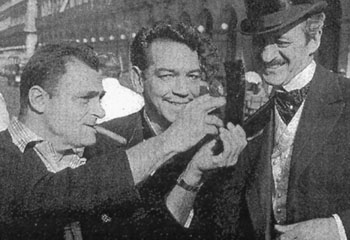 Michael
Todd demonstrating 70mm to Cantiflas and David Niven on a Paris street
during filming of "Around the World in 80 Days" Michael
Todd demonstrating 70mm to Cantiflas and David Niven on a Paris street
during filming of "Around the World in 80 Days"FIR: ls it true that your father ended up owning 78% of “Around the' World in 80 Days”? Todd: Yes. He spent two years producing the film and he wanted to own it completely. He paid Korda $100,000 for rights, and if he hadn't given CBS 10% for three quarters of a million, he would have owned 88%. He got the film started on his money from the Todd-AO sale, and borrowed money from Lorraine Manville. As a part of a distribution deal, negotiated near post-production, UA gave him four million for 10%, and a friend of his, Al Strelsin, got 1.8% for a $250,000 emergency loan during the Western shoot. Dad was fanatical about making the film as good as possible. He reshot a quarter of a million dollar scene where Phileas Fogg chops up a ship to use for fuel, because he thought the use of a miniature so close to the end would ruin the reality of the film. And after the film opened in 1956 to unanimous raves, he trimmed another six minutes based on watching audience reactions from the back of the theater - including part of the Western sequence he had directed - for an additional $250,000. When the new cut opened in December in Los Angeles, the reviews were as good or better than those in New York, and the film received the New York Film Critics Award in January [1957] as Best Film of the Year. And in April of 1957, despite my father's arrogance and anti-Hollywood attitude; “80 Days” won the Best Picture Oscar. He leapt out of his seat, started to run up the aisle, then turned back and kissed Elizabeth [Taylor, to whom he was married] before finally going up onto the stage.
When the film opened in London, he threw a party for the entire audience. He rented 10 boats, buses brought everybody down to the embankment, and there were bands playing and bars serving champagne on every boat.
The Daily Mirror suggested on their front page that he be knighted. |
|
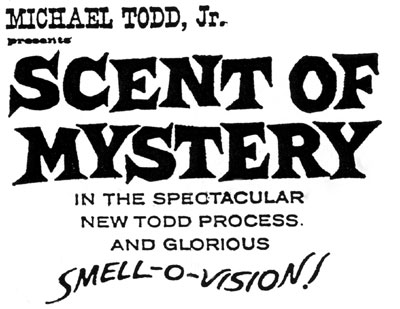 FIR: For the London opening, he beat a British tax regulation by having the 70mm version optically reduced. FIR: For the London opening, he beat a British tax regulation by having the 70mm version optically reduced.Todd: Yeah, he was very inventive. He had the picture printed down from the 65mm negative to 35mm - a new and expensive process - and then had an additional 1mm trimmed off one edge. The print-down [Cinestage] version was 34mm wide, and retained the detail of the 70mm prints. In fact, Dad was so happy with the results, that the second wave of US bookings all received 35mm print-down versions projected on Todd-AO-sized screens, and no one detected a difference. FIR: What about his anti-Hollywood attitude? Todd: He saw himself as a New Yorker. He planned to produce more films, including “Don Quixote” and “The Man Who Would Be King”, but they would be shot mainly on location, and he saw no reason to be based in Califonia. He also thought Los Angeles was an awful place to raise children. FIR: The film grossed $23 million. I guess that had to have been the ultimate independent film deal. Your father died at the absolute height of his success. Todd: Yes. At one point he said, "I'm so happy, there ought to be a law against it." FIR: Does money still come in from the film? Todd: I don't know. You'd have to ask Elizabeth. I sold my share to her. FIR: The one-year anniversary party at Madison Square Garden is a great story, too. Todd: That was absolutely fabulous. I mean, a disaster, but fabulous. Vincent Korda decorated the Garden. CBS paid my father $175,000 to air it, and they pre-empted Playhouse 90, their highest-rated dramatic series. Walter Cronkite narrated. Eighteen thousand people showed up. I really was just a spectator. I was sitting with Elizabeth. That is, after I stepped on her dress and ripped the hero. At the end, before Dad left, after everything had gone wrong, he threw me the keys and said "Here, kid, lock up”. Later we found out that he'd been the unexpected star of the show. The TV director kept zooming in on him, shouting and jumping up and down, waving his fists trying to keep the show going. CBS got one of the highest Nielsen ratings of the year, and “80 Days”' box office in the smaller cities around the country went up 15 to 25% and stayed there for months. |
|
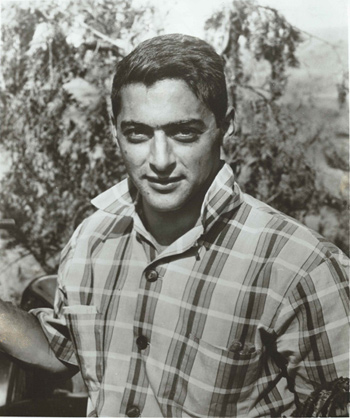 Mike
Todd, Jr. private still from Susan Todd's collection Mike
Todd, Jr. private still from Susan Todd's collectionFIR: Following the Garden fiasco, your father chose to send out a do-it-yourself party kit in Los Angeles rather than throw another party. Todd: It was just to poke a little fun at himself, and it was a clever way of keeping the thing going. FIR: Did Welles ever see “Around the World in 80 Days” and comment on it? Todd: I spent three days with Welles for a TV documentary I did about my father called “Around the World with Michael Todd”. I don't think we ever discussed “80 Days”. FIR: What was Welles like to work with? Todd: He was like Orson Welles. Shrouded in mystery. I had a hell of a time getting in touch with him. He was editing whatever he was working on in Bavaria, at the film studios there, so in order to shoot him we had to go to Munich, and when I met him at the hotel, he appeared in the lobby wearing a big cape. My partner lined up that mad prince's palace, and we used two rooms as if they were Welles' offices. And it was a very complicated tracking shot that my partner had set up to start off his narration, going from one room into another. It was too ambitious. We ran through it with Welles, who then spent five minutes and straightened the whole thing out and got it in one take. He looked at the script when he arrived on the set. I had written it, you know - and sat down with me - and it all was very psychological: He was sitting in a very tall chair and I was literally sitting at his knees. He wrote all his stuff in about 15 minutes and greatly improved it. And did everything in one take. He was absolutely brilliant and very amusing, but a real liar. A real fabricator. FIR: Where's “Around the World With Michael Todd” today? Todd: The negative's sitting with my partner in Florida. I made up three copies of it when my book about Dad came out in 1984. I gave two copies to TV people, who ripped them up, and I never got them back. My partner's putting it on video for me; but first they've got to put the pieces together. FIR: Something you didn't get around to discussing in your book, which I'd love to ask you about, is Smell-O-Vision. Todd: The funny thing about the process is that Bill Doll, Dad's press agent, and then mine for that project, had an idea that would have saved the damned thing if we'd thought of it before the film opened. And that was to reverse the pump. It sucked air back, so that there was no overhang on the previous smell. Otherwise it just sort of drifted in between smells. It wasn't over powering, but just enough not to make the clearest delineation. Bill got this idea after the third opening. It was used, and it worked perfectly, but by that time the ship had sailed. FIR: I saw it twice in New York, and it worked fine for me. Todd: We must have done it for Chicago and New York, after Doll got the idea. FIR: Did it seem to you at the time that this had the potential to be something like Cinerama. Todd: No. It was just a novelty gimmick. Maybe, if it was a gigantic hit, you might make a second film, and at the most, a third, but that would have been it. Our sincerest thanks to Michael Todd Jr. for allowing us access to his father's archives, from which all uncredited photographs came. |
19. April
2005 Hi Thomas, It seems the facade of the Cinestage still exists but it no longer functions as a movie theater. It's good to know the Goodman theater now exists there ! They have a first rate reputation for live theater. Ken Dubin, Chicago, USA |
|
Go: back
- top - back issues
- news index Updated 22-01-25 |
|
